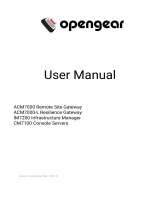
18
2.4 Serial Port Connection
The RJ45 serial ports are located on the rear of the B092-016 Console Server, on the front of the B096-048/032/016
Console Server and B094-008 Console Server, and on the side panel of the B095-004/003 Console Server. These Console
Servers use the RJ45 pinout used by Cisco. Use straight through RJ-45 cabling to connect to equipment such as Cisco,
Juniper, SUN, and more.
PIN SIGNAL DEFINITION DIRECTION
1 CTS Clear To Send Input
2 DSR Data Set Ready Input
3 RXD Receive Data Input
4 GND Signal Ground NA
5 GND Signal Ground NA
6 TXD Transmit Data Output
7 DTR Data Terminal Ready Output
8 RTS Request To Send Output
Conventional Cat5 cabling with RJ45 jacks are used for serial connections. Before connecting the console port of an external
device to the Console Server serial port, confirm that the device supports standard RS-232C (EIA-232).
The Console Server also has a DB9 LOCAL (Console/Modem) port. This DB-9 connector is on the rear panel of the B092-016
Console Server, and on the front panel of the B096-048/032/016 Console Server Management Switch.
2.5 USB Port Connection
The B096-048/032/016 Console Server Management Switch has one USB 1.0 port on the front panel and two USB 2.0 ports
on the rear. External USB devices can be plugged into these USB ports.
Note: The B096-048/032/016 Console Server Management Switch ships with an internal 16GB USB memory which can be
used for extended log file storage
The B094-008-2E-M-F / B094-008-2E-V Console Server has two USB 2.0 ports on the front. External USB devices can be
plugged into these USB ports.
Note: The B094-008-2E-M-F / B094-008-2E-V Console Server ships with an internal 4GB USB memory which can be used
for extended log file storage
There are four USB 2.0 ports on the rear panel of the B092-016 Console Server and one USB2.0 port located under the RJ45
10/100 LAN connector on the B095-004/003 Console Server. These ports are used to connect to USB consoles (of managed
UPS hardware) and to other external devices (such as a USB memory stick or keyboard).
External USB devices (including USB hubs) can be plugged into any Console Server USB port.
2.6 Rackmount Console / KVM Connection (B092-016 only)
B092-016 Console Server with PowerAlert can be connected directly to a rackmount console (such as B021-000-17
or B021-019 by Tripp Lite) to provide direct local management right at the rack. Connect the rackmount console’s PS/2
Keyboard/Mouse and VGA connectors directly to the PS/2 and VGA connectors on the B092-016. The default video resolution
is 1024 x 768. The B092-016 Console Server also supports the use of a USB keyboard/mouse.
Alternately, the B092-016 Console Server can also be connected locally to a KVM (or KVMoIP) switch at the rack. The B092-
016 Console Server with PowerAlert will enable you then to use this KVM infrastructure to run PowerAlert, to manage your
power devices and to run the thin clients to manage other devices.
Note: Care should be taken in handling all Console Server products. There are no operator-serviceable components inside, so
do not remove cover. Refer any service to qualified personnel
Chapter 2: Installation
























